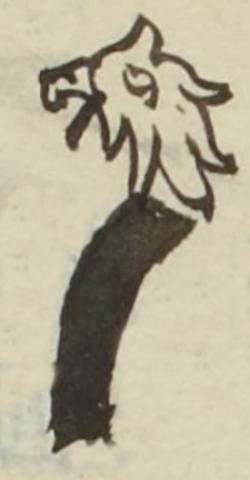Itzcuauh (MH499v)
This black-line drawing of the compound glyph for the personal name Itzcuauh (perhaps meaning "Golden Eagle" is attested here as a man’s name) shows an upright obsidian blade (itztli) curving toward the right and, above that, an eagle's head in profile, looking toward the viewer's left. The eagle (cuauhtli) has tufts of feathers sticking up all around its head. Its beak may be open. If Itzcuauh is not short for itzcuauhtli, golden eagle, then another possibility could be a partially phonetic rendering of itzcuahuitl, the obsidian-bladed club, and in that case the eagle's head could be a phonetic indicator for wood (cuahuitl).
Stephanie Wood
The man's name, Itzcuauh, was also held by one of Moctezuma's lords who played a vocal role during the Spanish invasion of the capital, and it was the name of an actual bird that, according to Clavijero (1844), not only hunted other "large birds and hares, but it also attacks wild beasts and men." The context image for this glyph shows that Martín Itzcuauh worked in textiles, for there is a spindle above his name.
Stephanie Wood
mīn
ytzguauh
Martín Itzcuauh
Stephanie Wood
1560
Jeff Haskett-Wood
feathers, plumas, nombres de hombres

itzcuahu(itl), an Indigenous weapon like the macuahuitl, https://nahuatl.wired-humanities.org/content/itzcuahuitl
itzcuauh(tli), golden eagle, https://nahuatl.wired-humanities.org/content/itzcuauhtli
itz(tli), obsidian blade, https://nahuatl.wired-humanities.org/content/itztli
cuauh(tli), eagle, https://nahuatl.wired-humanities.org/content/cuauhtli
Itzcuauhtzin, interim ruler of Tlatelolco at the time of the Spanish invasion, https://nahuatl.wired-humanities.org/content/itzcuauhtzin
Obsidiana-Águila
Stephanie Wood
Matrícula de Huexotzinco, folio 499v, World Digital Library, https://www.loc.gov/resource/gdcwdl.wdl_15282/?sp=78&st=image
This manuscript is hosted by the Library of Congress and the World Digital Library; used here with the Creative Commons, “Attribution-NonCommercial-ShareAlike 3.0 License” (CC-BY-NC-SAq 3.0).





